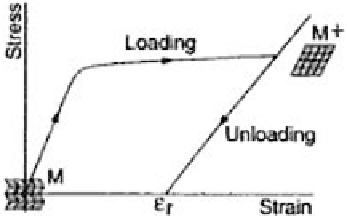Biomedical Engineering Reference
In-Depth Information
Similar reaction occurs during unloading. Material tends to
reveal almost linear relation of stress to strain when the level
of decreasing stress exceeded
σ
As
, and it starts a reversible
transformation from martensite to austenite. It is critical to have a
temperature range, which has to be considered for fully reversible
transformation.
In a high-temperature regime, where the temperature of
material is maintained above
A
f
, fully shape recovery is observed
and during unloading, this phenomenon is call pseudoelasticity or
transformational superelasticity.
During the full cycle of pseudoelastic transformation,
comprehended as austenite to martensite and reverse martensite
to austenite, we deal with generating in stress to strain system —
hysteresis curve, which is a result of the energy dissipation during
process. The curve's shape and values of stress levels strongly
depend on the material and measurement conditions.
For the temperature range of thermodynamic stability of
martensite phase, beneath
M
f
during loading, macroscopic change
of shape occurs as a result of detwinning mechanism. During
unloading, deform detwinned structure of martensite phase retains
a residual strain in the form of elongation
ε
r
as shown in Fig 8.15.
Figure 8.15
Stress to strain relation during loading for SMA at
thermodynamic stable martensite temperature range [41].
This low-temperature behavior is call
quasiplasticity
as
opposed to plastic deformation, characterized by permanent
deformation of structure. After heating the material in temperature
range higher than
A
f
, the accumulate strain is removed from
the structure and the reversible transformation to austenite is
achieved as shown in Fig. 8.16. This behavior is called shape memory
effect (SME) and will be discussed now.

















